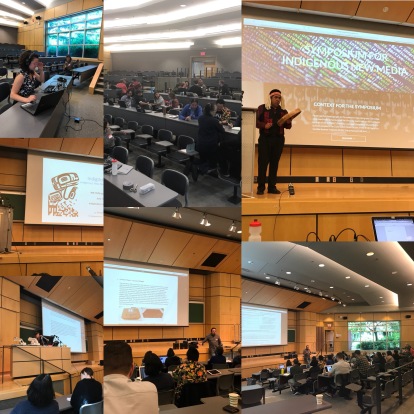
The following list was compiled out of the Symposium for Indigenous New Media (#SINM18), which was held as part of the Digital Humanities Summer Institute (DHSI) in June, 2018. We welcome your feedback and suggestions in the comments below.
1) Be a good relation: build meaningful relationships with community and individuals and resist parachute DH-ing. This means reaching out before, during, and after a project, lending support and resources for issues not necessarily connected to the research, and ensuring that participants have ample time to comment on drafts and final reports. Being a good relation also requires administrative support: the time and emotional labour put into Indigenous DH, particularly by Indigenous peoples, must be better recognized by department heads and tenure committees
2) People over tools: this means, simply, that the community should always matter more than tool or research you are developing. Oftentimes, this can mean letting a project before it is complete if you don’t have the support. It might also mean rethinking your research schedule (and maybe your tenure clock)—no matter how mind-blowing and useful the tool you designed might be.
3) Consent: Do better. Settler colonialism (colonialism premised on the displacement and erasure of Indigenous people) is already built out of a non-consensual relationship, so we need to hold ourselves to a higher standard as researchers working with community. All too often, and this is perhaps amplified in the post-TRC moment, Indigenous buy-in is an afterthought in academic research—a box to be checked after the project has been completed or is near completion. Being accountable to the community or person you are working with and that means checking in throughout the project. A yes at the beginning is not a yes at the middle or end. DH needs to be a bastion for consent if it is to be worthwhile for any of the communities we claim to serve. This means starting at the core of our relationships: the non-consent of actions performed on stolen land.
4) Take data sovereignty seriously: Tahu Kukutai and John Taylor write that Data sovereignty is “linked with indigenous peoples’ right to maintain, control, protect and develop their cultural heritage, traditional knowledge and traditional cultural expressions, as well as their right to maintain, control, protect and develop their intellectual property over these.” In Canadian contexts, this means holding up the principles of OCAP (Ownership, Control, Access, Permission), as developed by the First Nations Information Governance Centre, and rejecting, as Christen puts it, the liberal dictum of “information wants to be free.” If you are fortunate enough to work with community, realize that their rules of data stewardship may different than your field’s or your institution’s. While it may be “legal” for you to use data in a particular way, recognize that the university has been complicit in the theft of Indigenous knowledge since the onset of colonization. As with consent, hold yourself to a higher standard and familiarize yourself with the guidelines that are available.
5) Include Indigenous thinkers, programmers on your syllabi: not only is there a wealth of critical and creative Indigenous content out there that you and your students will benefit from studying—but including Indigenous technologies on a new media or DH syllabus is a political act. The settler colonial project works by simplifying Indigeniety and relegating it to the past. Indigenous digital humanities holds up Indigenous presence and Indigenous futures and we need to train the next generation of scholars to read with Indigenous technology.
6) Make safe spaces for Indigenous students: Adam Gaudry and Danielle Lorenz have written about how, in the post-TRC moment, universities are scrambling to Indigenize, that is hiring Indigenous faculty and recruiting Indigenous students. However, he argues, they are doing much less towards decolonizing, which is to say that the colonial infrastructure of universities is going largely unchanged.[1] Supporting Indigenous students means advocating for tenure-stream Indigenous positions and cluster hires, but it also means making safe spaces (URL and IRL) available for Indigenous students to share ideas and support one another. Further, if you are asking students to engage in open access platforms, remember that Indigenous peoples and particularly in Indigenous women and Indigenous queer/no-binary folk are much more likely to be subject to online racism violence and hate. (cite) Be thoughtful in your consideration of digital spaces to mobilize Indigenous voices. Look to platforms where students can work together with systems of support in place.
Engaging (or making) Indigenous new media means thinking about:[2]
Makers: Who are they? Who are they accountable to? Who do they make work for and why?
Audiences: How are they connected to the work? Are all of them necessary?
Land: How is land represented? Where are the servers? What’s being (re)mediated, and how?
Sovereignty: Who controls the data? Who has access? How can tech galvanize community?
Self-determination: Who gets to tell the story? Who is credited? Who benefits?
Consent: Who can give (or withdraw) consent to data? Who is taking it? How do we protect it?
Surveillance: Who is watching? To what end? Is the exchange worth it?
Protocol: How do we respectfully engage? How do we respectfully create?
Accessibility: Who can/can’t access it? Who should/shouldn’t? What are the barriers?
Empowerment: Who gets to tell their story? Who gets to teach? Who gets to learn?
History: Who gets to define “technology”? Who is ignored?
Futures: Whose future does technology service? How do we imagine otherwise?
[1] Adam Gaudry and Danielle Lorenz, “Indigenization as inclusion, reconciliation, and decolonization: navigating the different visions for indigenizing the Canadian Academy.” AlterNative: An International Journal of Indigenous Peoples 14.3 (2018): 218-227.
[2] This list was inspired by Jentery Sayers, “Unlearning the Internet, Course Review
